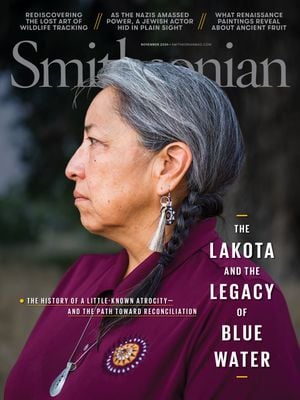Back in the 19th Century, Your Election Ballot Could Double as a Work of Art
During and after the Civil War, inventive illustrations allowed Democrats and Republicans to turn American ballots into powerful propaganda
:focal(1050x750:1051x751)/https://tf-cmsv2-smithsonianmag-media.s3.amazonaws.com/filer_public/69/81/698163bc-17a8-4db6-b50f-9d867278cdeb/ballots_web.jpg)
In the mid-19th century, election ballots were created by political parties, not the government. Local Republican and Democratic operatives designed and printed their own ballots, also called tickets, which typically listed each party’s candidates for state, local and federal office. At the polls, voters procured ballots from party workers and, after walking through a crowd, dropped their votes into a ballot box, typically a glass bowl. With no secrecy in how one voted, violence and intimidation became common, particularly in urban precincts.
/https://tf-cmsv2-smithsonianmag-media.s3.amazonaws.com/filer_public/8c/e1/8ce118db-d9a1-4ff2-b4c3-03b08516f1de/nov2024_i18_prologue.jpg)
Lincoln Financial Foundation Collection, courtesy of the Allen County Public Library
/https://tf-cmsv2-smithsonianmag-media.s3.amazonaws.com/filer_public/cc/d2/ccd243c3-2279-4be5-b1e4-9401c513c40e/untitled-2.jpg)
To capture the attention of voters on Election Day, local party organizations often turned their ballots into miniature works of art, using patriotic and partisan symbols to appeal to voters. Such artwork also had practical uses: Illiterate or non-English-speaking voters might be drawn to a ballot that seemed to represent their political views. In many cases, voters did not even bother to read the names on the ballots, enabling some unscrupulous politicos to use their opponents’ symbols to trick inattentive voters. One semi-literate voter admitted in 1863, “I cannot say exactly whether I read the ticket or not; mostly I get the ticket from a man, knowing his politics, and knowing that he feels as I feel myself.”
When President Abraham Lincoln ran for re-election in 1864, Republicans throughout the nation printed ballots with pro-war and pro-Union symbols, slogans and song lyrics. In one of the most beautiful and detailed examples, the Grant Club of San Francisco, a Republican organization with a thousand members, printed ballots depicting the 1864 Battle of Cherbourg, an important naval engagement between the Union and the Confederacy, in which the USS Kearsarge defeated the CSS Alabama off the northwestern coast of France. When members of the Grant Club marched to Bay Area polls on November 8 for that year’s presidential election, they proudly carried the Lincoln tickets they’d designed and printed.
Ballots often featured portraits of a party’s most popular candidates. Lincoln would continue to appear on Republican tickets well into the postwar years, inspiring Northern Civil War veterans to vote as they had shot—against Southern Democrats—even once the guns had fallen silent.
/https://tf-cmsv2-smithsonianmag-media.s3.amazonaws.com/filer_public/15/d4/15d45594-73e3-48bc-9938-868ac3b36d17/nov2024_i16_prologue.jpg)
Lincoln Financial Foundation Collection, courtesy of the Allen County Public Library
/https://tf-cmsv2-smithsonianmag-media.s3.amazonaws.com/filer_public/c3/fd/c3fdcc5e-dd6f-458f-941c-dc66fa44eb21/nov2024_i17_prologue.jpg)
